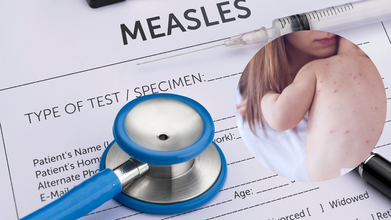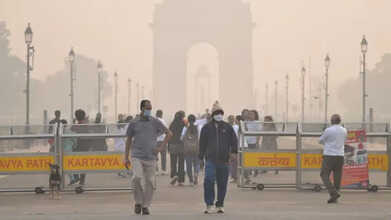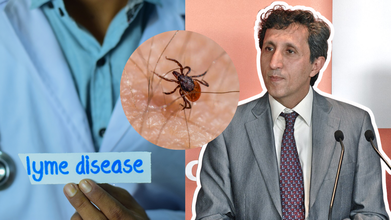- Health Conditions A-Z
- Health & Wellness
- Nutrition
- Fitness
- Health News
- Ayurveda
- Videos
- Medicine A-Z
- Parenting
- Web Stories
Measles Outbreak: Cases Surge In South Carolina; After US, Canada's Elimination Status Too Could Be Threatened

Credits: Canva
Measles Outbreak: Measles is back again in America, with the Upstate South Carolina being hit by the outbreak again, and grown by 2 more cases. This has raised the state total to 25.
Health officials have confirmed that both the new infections were linked to close contacts of known cases. Those two in contact were under quarantine at home following exposures at two schools that had a high percentage of unvaccinated students. Of the state's 25 cases, 22 have occurred as part of the Upstate outbreak.
New York’s Rockland County has confirmed its second measles case in three months. The county, which saw a major measles outbreak in 2018–19 and has a sizable unvaccinated population, is once again on alert. Health officials said the new case is unrelated to the one reported in August, with the patient developing a rash soon after returning from an overseas trip last week.
Canada's Elimination Status Could Be Threatened By Measles Cases
October 28 marked one year of continuous measles transmission in Canada. This is a cycle of virus activity that is now threatening the country's elimination status.
As of now, the country has had more than 5,100 cases. This has been noted since the fall of 2024. This is more than double the number recorded in the past 25 years combined, which is why it is a cause of concern.
Canada had eliminated measles in past. In 1998, the disease was eliminated, however, with the new situation, the status of the country now seems to be in jeopardy. This is also because the elimination status requires an absence of the local virus transmission for at least 12 months.
According to CNN, the Pan American Health Organization (PAHO) is set to review and assess the measles elimination status of several North American countries during its annual meeting next month. In Canada, nearly 90% of the measles cases reported over the past year have occurred among unvaccinated individuals. Moreover, all but 157 of these cases have been linked to the ongoing outbreak that began in Ontario in October 2024.
In Israel too, as confirmed by The Jerusalem Post, eight child has died due to measles outbreak in the nation. The recent death is of a child, who was just 2-year-old. In Israel, all deaths in this outbreak have been noted in unvaccinated children under age 3 years.
Could US Too Lose Its Eliminated Status?
Measles has held “eliminated” status in the United States since 2000, a designation that means there had been no year-long, uncontrolled spread of the virus within the country for decades. But that milestone is now in jeopardy.
The infection is spreading again, and the Centers for Disease Control and Prevention (CDC) has reported 1,596 confirmed cases this year, the highest annual total in over thirty years. The actual number could be higher, says Dr. Paul Offit, director of the Vaccine Education Center at the Children’s Hospital of Philadelphia.
Why Are Cases Increasing In The US?
In Mohave County, Arizona, vaccination coverage among kindergartners dropped from 91% in 2019–20 to 78% in 2024–25, with a similar decline noted in southwest Utah.
Public health experts stress that at least 95% vaccination coverage is necessary to prevent the virus from spreading. Both Utah and Arizona allow parents to exempt children from school vaccine mandates on personal or religious grounds, leaving pockets of unprotected populations. Vaccine hesitancy has deepened since the Covid-19 pandemic, fueled by political polarization and a decline in public trust toward health authorities. Notably, most of the affected towns voted heavily for Donald Trump in the 2024 election, underscoring how politics and misinformation continue to shape vaccination decisions.
Delhi’s Artificial Rain Plan To Fight Toxic Smog Fails— Here’s Why It Didn’t Work

Credits: PTI
Artificial Cloud Seeding Delhi: Delhi has long struggled with toxic air. The city often records high pollution levels throughout the year, and in an effort to provide cleaner air to residents, the Delhi government has been exploring cloud seeding or artificial rain for several months.
After more than five decades, Delhi finally carried out cloud seeding trials to trigger artificial rain and bring down rising pollution levels. The project was a joint effort between the Delhi government and the Indian Institute of Technology (IIT) Kanpur, conducted in areas such as Burari, Karol Bagh, Mayur Vihar, and Badli.
However, the experiment failed, as the India Meteorological Department (IMD) did not record any rainfall in the city.
Why Cloud Seeding Failed in Delhi?
According to an NDTV report, IIT Kanpur Director Manindra Agrawal said the attempt was “not completely successful” because the clouds did not have enough moisture. “For rain to form, moisture levels of at least 50 percent are ideal,” he said. “Today’s clouds only had about 15–20 percent moisture, which reduced the chances of rainfall.”
Despite the low humidity, Agrawal said the exercise gave researchers valuable experience and confidence that the method could work under more favorable conditions. While Delhi saw no rainfall, small traces were recorded in Noida (0.1 mm) and Greater Noida (0.2 mm). Two more flights will be carried out once suitable clouds appear.
A report released by the Delhi government on Tuesday evening showed a slight drop in pollution levels in areas where the seeding took place. According to PTI, PM2.5 levels fell marginally in Mayur Vihar, Karol Bagh, and Burari. Environment Minister Manjinder Singh Sirsa called it a “major scientific step” in tackling air pollution and said more trials, possibly up to 10, will be conducted until February if the results remain encouraging.
What Is Cloud Seeding?
Cloud seeding involves adding substances like silver iodide or dry ice to clouds to encourage rainfall or snowfall, reduce hail, or clear fog. It can be carried out using aircraft, rockets, or ground-based equipment.
The formula developed by IIT Kanpur includes silver iodide nanoparticles, iodised salt, and rock salt. These particles act as ice nuclei, helping moisture in the clouds condense and form rain. However, the process depends heavily on having the right level of humidity and moisture in the atmosphere.
Will a Third Round of Cloud Seeding Take Place?
A third round of trials is likely later this week, depending on IMD confirmation of suitable cloud conditions. Similar operations are expected in the coming days. Sirsa told ANI that IIT Kanpur has been collecting large-scale samples during the experiments and will submit a detailed report soon.
Globally, cloud seeding has produced mixed outcomes. China has reported success with using rockets, cannons, and drones to manage rainfall, including before the Olympics. In contrast, the United Arab Emirates faced criticism after last year’s floods in Dubai, raising questions about the method’s safety and reliability.
Dr. Amir Khadir Pleads Guilty Over Controversial Treatments for a Nonexistent Form of Lyme Disease

Credits: Canva and Wikimedia Commons
Dr Amir Khadir, microbiologist and infectious disease specialist at Pierre-Le Gardeur Hospital in Terrebonne, Quebec, Canada pleaded guilty to 12 offences over his controversial treatment of Lyme disease. He had been treating patients with "chronic" Lyme disease since 2019 in his specialized clinic, affiliated to the hospital. However, science does not back that such a condition even exists, confirmed the disciplinary council of the Collège des médecins du Québec (CMQ).
In June 2020, he made a commitment to stop prescribing antibiotics beyond 28 days to treat people with Lyme disease, however, some patients have taken his medications for two years. His long-term antibiotic treatment lasted for more than four months up to two years in his patients.
Also Read: Is The White House Hiding Truth About President Donald Trump’s Health?
What Happened In The Past?
Dr Steven Lapointe, who is a CMQ trustee said that Dr Khadir "admitted four times rather than once that he had not respected his commitment. He spent much more time justifying himself than expressing regret, and even less remorse, for not having respected his commitment. [He made] his own law."
Dr Khadir justified his deed by saying that some of his desperate patients had recovered after prolonged course of antibiotics. He said that there were no complains from his patients about his approach. No complications were reported either.
Dr Khadir had earlier made the government aware of the need to undertake a research and was hoping to seek funding for the same. Le Journal de Montreal reports that he was not to offer antibiotic treatment for Lyme disease for more than 28 days, except as part of a hospital research project. However, as Montreal City News reports, that though he received the approval of the medical and political communities, the fundings had not come, as Quebec allocated the funds for a group of clinics specializing in long COVID and infectious diseases. Thus, he continued to offer antibiotic treatment beyond 28 days outside of a research setting.
"I regret not having done things in the right order. It was a lamentable error of judgment," he said.
Also Read: As U.S. Measles Cases Surge, Could The Country Lose Its Elimination Status?
What Is The Right Way To Treat Lyme Disease?
As per the Centers for Disease Control and Prevention (CDC), most cases of Lyme diseases are treated within 10 to 14 days of antibiotics.
Mayo Clinic notes that the standard treatment for Lyme disease is an antibiotic taken as a pill that lasts 10 to 14 days.
Cleveland Clinic also notes that while antibiotics are the primary treatment for Lyme disease, including doxycycline, amoxicillin, or cefuroxime axetil. The time taken to recover could be around 10 days.
Johns Hopkins Medicine notes that treatment could last up to 21 days.
What Is Lyme Disease?
It is a bacterial infection spread by infected ticks. The initial symptoms can include a 'bull's eye' rash, fever, headache, and fatigue. If it is left untreated, the infection could spread and cause more serious problems affecting joints, heart, and even the nervous system. It is most effectively treated, as many have noted and has been mentioned above, with antibiotics, especially when caught early.
New Mpox Strain Detected in California Sparks Health Alert

Credits: Canva
More than two years after the mpox outbreak in the United States was officially declared over, a fresh cluster of cases in California has caught the attention of infectious disease experts.
The previous U.S. outbreak, which spread primarily among men who have sex with men, was declared over in early 2023, though sporadic cases have continued to appear. Now, health officials are worried after identifying three unrelated mpox cases in California linked to a more infectious and potentially more severe strain of the virus known as clade I mpox.
What Is Mpox?
Mpox, previously called monkeypox, is a viral infection caused by the monkeypox virus, a member of the Orthopoxvirus genus. According to the World Health Organization, the virus is divided into two main groups—clade I (which includes Ia and Ib) and clade II (which includes IIa and IIb). The 2022–2023 global outbreak was linked to the clade IIb strain. The disease continues to pose a global health concern, with a sharp rise in cases reported in the Democratic Republic of the Congo and other regions due to clades Ia and Ib, and now in the United States.
How This Strain Differs From the 2022 Outbreak
The mpox variant responsible for the 2022 outbreak belonged to clade II, a strain with a relatively low fatality rate. During that outbreak, over 32,000 infections were reported nationwide, resulting in 58 confirmed deaths—a mortality rate of about 0.2 percent.
Clade I mpox, by comparison, has been found to cause more serious illness and spread more easily. Both strains exist in parts of Central Africa, but clade I has historically shown higher transmissibility and mortality than clade II.
California Cases Raise Alarm Over Possible Community Spread
All three of the California patients infected with the clade I strain required hospitalization. According to the California Department of Public Health (CDPH), the pattern of infection suggests that, much like the 2022 outbreak, transmission is again occurring primarily within networks of men who have sex with men.
Dr. Joseph Cherabie, assistant professor of infectious diseases at Washington University in St. Louis and a board member of the HIV Medicine Association, said it was “only a matter of time” before clade I reached the U.S.
While a previous California case of clade I mpox was linked to travel in Africa, these recent infections have no known travel connections, a detail that worries experts. “That makes us a little bit uncomfortable as epidemiologists and as public health folks,” Cherabie said, adding that it signals local transmission that health authorities may not yet be fully detecting.
Transmission and Concerns About Undetected Cases
Mpox spreads mainly through direct skin-to-skin contact with someone who is infected, often through the painful rashes characteristic of the disease. Since the source of infection for these cases remains unclear, Cherabie believes there are likely more undetected cases circulating in the community.
When mpox first appeared in nonendemic countries in 2022, health agencies faced the challenge of having no treatments or vaccines made specifically for it. However, existing smallpox treatments were found to be effective against mpox, given their viral similarities.
Treatment and Vaccine Options
The smallpox vaccine Jynneos and the antiviral drug tecovirimat (Tpoxx) continue to be the leading tools for protection and treatment. Experts expect them to work against both clade I and clade II mpox.Jynneos requires two doses for complete protection, while Tpoxx can be given either intravenously or orally, depending on the severity of symptoms.
© 2024 Bennett, Coleman & Company Limited

